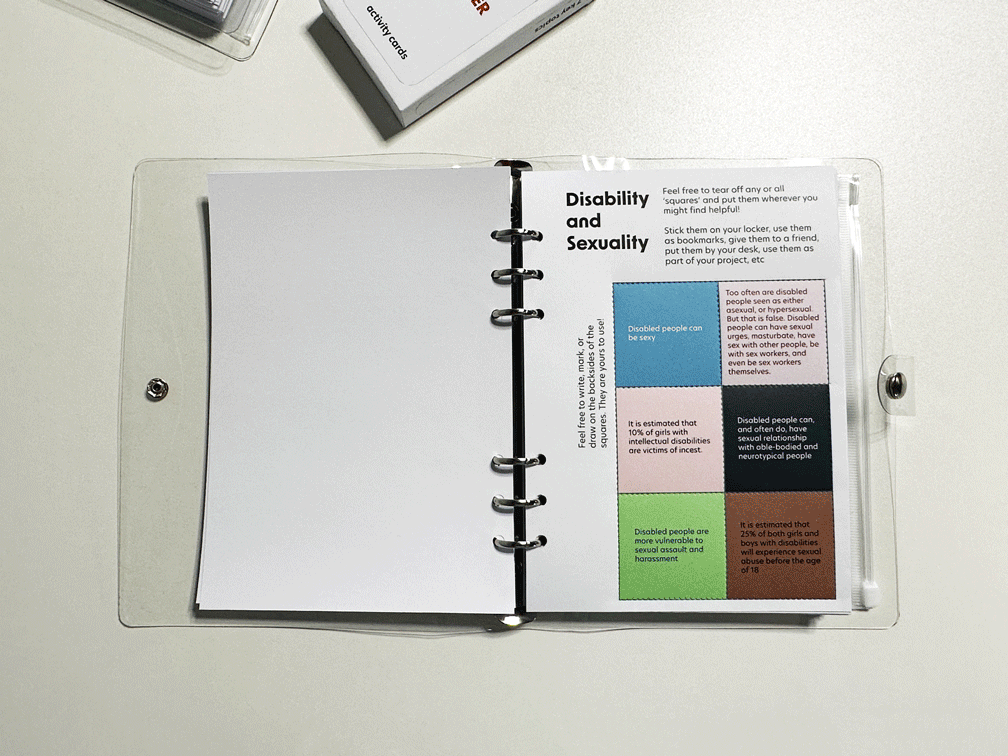

We Are In This Together
- Communal inclusion plan for art and design students
in higher education
[Real world potential and impact]
RCA, 2023

As awareness and acceptance of different kinds of disabilities are on the rise in many areas in the world, it’s good to see that the industry is encouraging actually disabled people to design, or at least, to co-design assistive technologies and in spheres related to disability. However, very little has been done to support disabled art and design students to navigate the dual identity of both an artist / designer and a disabled person.
WE ARE IN THIS TOGETHER aims to address the issues surrounding navigating higher education in art and design as a disabled person, through creating a handbook, a curated set of discussion objects, and a set of activity cards that would provide some guidance, prompt conversations around related topics, assist self and peer reflection, etc. In short, the project is envisioned to be a communal inclusion plan that welcomes everyone into the conversations surrounding disability and neurodivergent minds.

Diagram and schematics showing the interaction process for the activity cards and workbook


WE ARE IN THIS TOGETHER Workbook – The workbook is divided into 7 chapters, each covering different topics, ranging from more generic information about disability history, to more controversial issues such as terminologies or sexuality, as well as more nuanced or complex facets around disability, such as disability burnout, and clashing support needs.
For some pages, the content is organised into squares that can be torn off from the pages. The user can tear off the squares that they think appropriate and put them elsewhere, such as on their locker, use it as a bookmark, or give it to another person.


There are blank pages for the users to take notes on. They can use the pages however they want: to write down discussion topics, their self-discovery, something they’ve learnt through chatting with others, or even a doodle. Due to the customisable nature of the workbook, each person’s book would grow as the person grows. Although everyone would start off with the same copy, each copy would grow into its own unique and complex collection of thoughts, discussions, and memories, reflecting the person’s journey.
Apart from being colour-coded by the activity categories, the activity cards also have numbers on the back, correlating to different chapters in the workbook. The cards can be used in conjunction with the workbook. If the users only want to pick out cards relating to one specific chapter, they can select the cards with the same number from the deck. Or if they wish to know more about a certain topic while interacting with shuffled cards, they can also locate the corresponding chapter.

The activity cards, along with the tuck box, can be stored in the plastic pouch available in the workbook.

Activity Cards Version 2
Graphic design and visual identity created in collaboration with Beatrice Sangster
(RCA MA Visual Communication Alumni 2023)







Diagram and schematics showing the interaction process for the activity objects bag


The curated objects were selected based on either their prevalence in disabled people’s lives, or their interesting / controversial design history. Under or next to each object, written against a red background, is the discussion prompt. The user needs to either take out the object first, or to take out the folded-up red paper to read the prompt.
The users can also keep and use certain objects in their everyday life if they wish. A good example would be the pop-it fidget toy, since many people would find it satisfying to play with.


For many of the curated objects, there are also corresponding LEARN cards, from which the user can learn about the facts and history of that particular object.


On the back of each card, braille letters QR are embossed next to the QR code. This would make it easier for blind and visually impaired people to locate and scan the code, which would then lead them to a digitised version of the same content on that particular card. They can then access the content using their screen readers. The image on the right shows what the ‘Hidden Disabilities’ page looks like as the digitalised version. All QR codes and digitalised content are updated and working.
Display for the RCA Degree Show 2023







